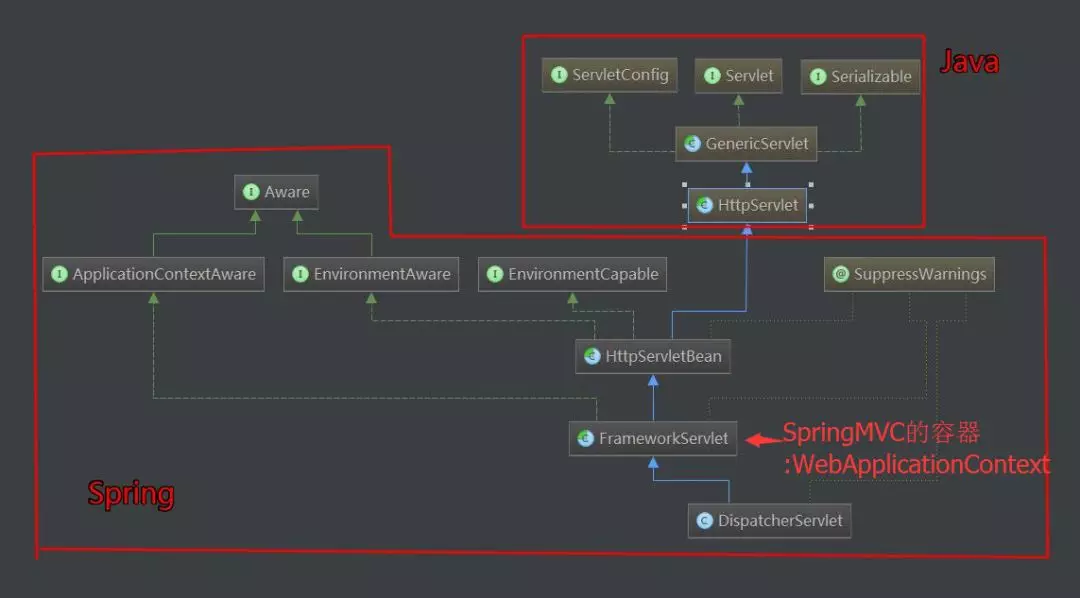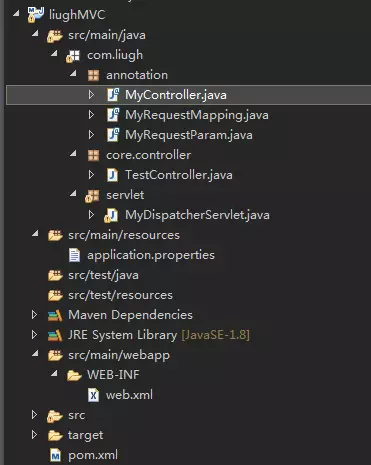一、瞭解SpringMVC運行流程及九大組件 1、SpringMVC 的運行流程 · 用戶發送請求至前端控制器DispatcherServlet · DispatcherServlet收到請求調用HandlerMapping處理器映射器。 · 處理器映射器根據請求url找到具體的處理器,生成處理器對 ...
一、瞭解SpringMVC運行流程及九大組件
1、SpringMVC 的運行流程

-
· 用戶發送請求至前端控制器DispatcherServlet
-
· DispatcherServlet收到請求調用HandlerMapping處理器映射器。
-
· 處理器映射器根據請求url找到具體的處理器,生成處理器對象及處理器攔截器(如果有則生成)一併返回給DispatcherServlet。
-
· DispatcherServlet通過HandlerAdapter處理器適配器調用處理器
-
· 執行處理器(Controller,也叫後端控制器)。
-
· Controller執行完成返回ModelAndView
-
· HandlerAdapter將controller執行結果● ModelAndView返回給DispatcherServlet
-
· DispatcherServlet將ModelAndView傳給● ViewReslover視圖解析器
-
· ViewReslover解析後返回具體View
-
· DispatcherServlet對View進行渲染視圖(即將模型數據填充至視圖中)。
-
· DispatcherServlet響應用戶。
從上面可以看出,DispatcherServlet有接受請求,響應結果,轉發等作用。有了DispatcherServlet之後,可以減少組件之間的耦合度。
2、SpringMVC 的九大組件

protected void initStrategies(ApplicationContext context) { //用於處理上傳請求。處理方法是將普通的request包裝成MultipartHttpServletRequest,後者可以直接調用getFile方法獲取File. initMultipartResolver(context); //SpringMVC主要有兩個地方用到了Locale:一是ViewResolver視圖解析的時候;二是用到國際化資源或者主題的時候。 initLocaleResolver(context); //用於解析主題。SpringMVC中一個主題對應一個properties文件,裡面存放著跟當前主題相關的所有資源、 //如圖片、css樣式等。SpringMVC的主題也支持國際化, initThemeResolver(context); //用來查找Handler的。 initHandlerMappings(context); //從名字上看,它就是一個適配器。Servlet需要的處理方法的結構卻是固定的,都是以request和response為參數的方法。 //如何讓固定的Servlet處理方法調用靈活的Handler來進行處理呢?這就是HandlerAdapter要做的事情 initHandlerAdapters(context); //其它組件都是用來幹活的。在幹活的過程中難免會出現問題,出問題後怎麼辦呢? //這就需要有一個專門的角色對異常情況進行處理,在SpringMVC中就是HandlerExceptionResolver。 initHandlerExceptionResolvers(context); //有的Handler處理完後並沒有設置View也沒有設置ViewName,這時就需要從request獲取ViewName了, //如何從request中獲取ViewName就是RequestToViewNameTranslator要做的事情了。 initRequestToViewNameTranslator(context); //ViewResolver用來將String類型的視圖名和Locale解析為View類型的視圖。 //View是用來渲染頁面的,也就是將程式返回的參數填入模板里,生成html(也可能是其它類型)文件。 initViewResolvers(context); //用來管理FlashMap的,FlashMap主要用在redirect重定向中傳遞參數。 initFlashMapManager(context); }View Code
二、自己實現 SpringMVC 功能分析
本篇文章只實現 SpringMVC 的配置載入、實例化掃描的包、HandlerMapping 的 url 映射到對應的Controller 的 method 上、異常的攔截和動態調用後返回結果輸出給瀏覽器的功能。其餘 SpringMVC 功能讀者可以嘗試自己實現。
1、讀取配置

從圖中可以看出,SpringMVC本質上是一個Servlet,這個 Servlet 繼承自 HttpServlet。
FrameworkServlet負責初始化SpringMVC的容器,並將Spring容器設置為父容器。因為本文只是實現SpringMVC,對於Spring容器不做過多講解(有興趣同學可以看看博主另一篇文章:向spring大佬低頭--大量源碼流出解析)。
為了讀取web.xml中的配置,我們用到ServletConfig這個類,它代表當前Servlet在web.xml中的配置信息。通過web.xml中載入我們自己寫的MyDispatcherServlet和讀取配置文件。
2、初始化階段
在上文中,我們知道了DispatcherServlet的initStrategies方法會初始化9大組件,但是本文將實現一些SpringMVC的最基本的組件而不是全部,按順序包括:
· 載入配置文件
· 掃描用戶配置包下麵所有的類
· 拿到掃描到的類,通過反射機制,實例化。並且放到ioc容器中(Map的鍵值對 beanName-bean) beanName預設是首字母小寫
· 初始化HandlerMapping,這裡其實就是把url和method對應起來放在一個k-v的Map中,在運行階段取出
3、運行階段
每一次請求將會調用doGet或doPost方法,所以統一運行階段都放在doDispatch方法里處理,它會根據url請求去HandlerMapping中匹配到對應的Method,然後利用反射機制調用Controller中的url對應的方法,並得到結果返回。按順序包括以下功能:
· 異常的攔截
· 獲取請求傳入的參數並處理參數
· 通過初始化好的handlerMapping中拿出url對應的方法名,反射調用
三、手寫 SpringMVC 框架
工程文件及目錄:

首先,新建一個maven項目,在pom.xml中導入以下依賴。為了方便,博主直接導入了Springboot的web包,裡面有我們需要的所有web開發的東西:

<project xmlns="http://maven.apache.org/POM/4.0.0" xmlns:xsi="http://www.w3.org/2001/XMLSchema-instance" xsi:schemaLocation="http://maven.apache.org/POM/4.0.0 http://maven.apache.org/xsd/maven-4.0.0.xsd"> <modelVersion>4.0.0</modelVersion> <groupId>com.liugh</groupId> <artifactId>liughMVC</artifactId> <version>0.0.1-SNAPSHOT</version> <packaging>war</packaging> <dependencyManagement> <dependencies> <dependency> <groupId>org.springframework.boot</groupId> <artifactId>spring-boot-dependencies</artifactId> <version>1.4.3.RELEASE</version> <type>pom</type> <scope>import</scope> </dependency> </dependencies> </dependencyManagement> <properties> <project.build.sourceEncoding>UTF-8</project.build.sourceEncoding> <maven.compiler.source>1.8</maven.compiler.source> <maven.compiler.target>1.8</maven.compiler.target> <java.version>1.8</java.version> </properties> <dependencies> <dependency> <groupId>org.springframework.boot</groupId> <artifactId>spring-boot-starter-web</artifactId> </dependency> </dependencies> </project>View Code
接著,我們在WEB-INF下創建一個web.xml,如下配置:

<?xml version="1.0" encoding="UTF-8"?> <web-app xmlns:xsi="http://www.w3.org/2001/XMLSchema-instance" xmlns="http://java.sun.com/xml/ns/javaee" xmlns:web="http://java.sun.com/xml/ns/javaee/web-app_2_5.xsd" xsi:schemaLocation="http://java.sun.com/xml/ns/javaee http://java.sun.com/xml/ns/javaee/web-app_3_0.xsd" version="3.0"> <servlet> <servlet-name>MySpringMVC</servlet-name> <servlet-class>com.liugh.servlet.MyDispatcherServlet</servlet-class> <init-param> <param-name>contextConfigLocation</param-name> <param-value>application.properties</param-value> </init-param> <load-on-startup>1</load-on-startup> </servlet> <servlet-mapping> <servlet-name>MySpringMVC</servlet-name> <url-pattern>/*</url-pattern> </servlet-mapping> </web-app>View Code
application.properties文件中只是配置要掃描的包到SpringMVC容器中。
scanPackage=com.liugh.core
創建自己的Controller註解,它只能標註在類上面:

package com.liugh.annotation; import java.lang.annotation.Documented; import java.lang.annotation.ElementType; import java.lang.annotation.Retention; import java.lang.annotation.RetentionPolicy; import java.lang.annotation.Target; @Target(ElementType.TYPE) @Retention(RetentionPolicy.RUNTIME) @Documented public @interface MyController { /** * 表示給controller註冊別名 * @return */ String value() default ""; }View Code
RequestMapping註解,可以在類和方法上:

package com.liugh.annotation; import java.lang.annotation.Documented; import java.lang.annotation.ElementType; import java.lang.annotation.Retention; import java.lang.annotation.RetentionPolicy; import java.lang.annotation.Target; @Target({ElementType.TYPE,ElementType.METHOD}) @Retention(RetentionPolicy.RUNTIME) @Documented public @interface MyRequestMapping { /** * 表示訪問該方法的url * @return */ String value() default ""; }View Code
RequestParam註解,只能註解在參數上

package com.liugh.annotation; import java.lang.annotation.Documented; import java.lang.annotation.ElementType; import java.lang.annotation.Retention; import java.lang.annotation.RetentionPolicy; import java.lang.annotation.Target; @Target(ElementType.PARAMETER) @Retention(RetentionPolicy.RUNTIME) @Documented public @interface MyRequestParam { /** * 表示參數的別名,必填 * @return */ String value(); }View Code
然後創建MyDispatcherServlet這個類,去繼承HttpServlet,重寫init方法、doGet、doPost方法,以及加上我們第二步分析時要實現的功能:

package com.liugh.servlet; import java.io.File; import java.io.IOException; import java.io.InputStream; import java.lang.reflect.Method; import java.net.URL; import java.util.ArrayList; import java.util.Arrays; import java.util.HashMap; import java.util.List; import java.util.Map; import java.util.Map.Entry; import java.util.Properties; import javax.servlet.ServletConfig; import javax.servlet.ServletException; import javax.servlet.http.HttpServlet; import javax.servlet.http.HttpServletRequest; import javax.servlet.http.HttpServletResponse; import com.liugh.annotation.MyController; import com.liugh.annotation.MyRequestMapping; public class MyDispatcherServlet extends HttpServlet{ private Properties properties = new Properties(); private List<String> classNames = new ArrayList<>(); private Map<String, Object> ioc = new HashMap<>(); private Map<String, Method> handlerMapping = new HashMap<>(); private Map<String, Object> controllerMap =new HashMap<>(); @Override public void init(ServletConfig config) throws ServletException { //1.載入配置文件 doLoadConfig(config.getInitParameter("contextConfigLocation")); //2.初始化所有相關聯的類,掃描用戶設定的包下麵所有的類 doScanner(properties.getProperty("scanPackage")); //3.拿到掃描到的類,通過反射機制,實例化,並且放到ioc容器中(k-v beanName-bean) beanName預設是首字母小寫 doInstance(); //4.初始化HandlerMapping(將url和method對應上) initHandlerMapping(); } @Override protected void doGet(HttpServletRequest req, HttpServletResponse resp) throws ServletException, IOException { this.doPost(req,resp); } @Override protected void doPost(HttpServletRequest req, HttpServletResponse resp) throws ServletException, IOException { try { //處理請求 doDispatch(req,resp); } catch (Exception e) { resp.getWriter().write("500!! Server Exception"); } } private void doDispatch(HttpServletRequest req, HttpServletResponse resp) throws Exception { if(handlerMapping.isEmpty()){ return; } String url =req.getRequestURI(); String contextPath = req.getContextPath(); url=url.replace(contextPath, "").replaceAll("/+", "/"); if(!this.handlerMapping.containsKey(url)){ resp.getWriter().write("404 NOT FOUND!"); return; } Method method =this.handlerMapping.get(url); //獲取方法的參數列表 Class<?>[] parameterTypes = method.getParameterTypes(); //獲取請求的參數 Map<String, String[]> parameterMap = req.getParameterMap(); //保存參數值 Object [] paramValues= new Object[parameterTypes.length]; //方法的參數列表 for (int i = 0; i<parameterTypes.length; i++){ //根據參數名稱,做某些處理 String requestParam = parameterTypes[i].getSimpleName(); if (requestParam.equals("HttpServletRequest")){ //參數類型已明確,這邊強轉類型 paramValues[i]=req; continue; } if (requestParam.equals("HttpServletResponse")){ paramValues[i]=resp; continue; } if(requestParam.equals("String")){ for (Entry<String, String[]> param : parameterMap.entrySet()) { String value =Arrays.toString(param.getValue()).replaceAll("\[|\]", "").replaceAll(",\s", ","); paramValues[i]=value; } } } //利用反射機制來調用 try { method.invoke(this.controllerMap.get(url), paramValues);//obj是method所對應的實例 在ioc容器中 } catch (Exception e) { e.printStackTrace(); } } private void doLoadConfig(String location){ //把web.xml中的contextConfigLocation對應value值的文件載入到留裡面 InputStream resourceAsStream = this.getClass().getClassLoader().getResourceAsStream(location); try { //用Properties文件載入文件里的內容 properties.load(resourceAsStream); } catch (IOException e) { e.printStackTrace(); }finally { //關流 if(null!=resourceAsStream){ try { resourceAsStream.close(); } catch (IOException e) { e.printStackTrace(); } } } } private void doScanner(String packageName) { //把所有的.替換成/ URL url =this.getClass().getClassLoader().getResource("/"+packageName.replaceAll("\.", "/")); File dir = new File(url.getFile()); for (File file : dir.listFiles()) { if(file.isDirectory()){ //遞歸讀取包 doScanner(packageName+"."+file.getName()); }else{ String className =packageName +"." +file.getName().replace(".class", ""); classNames.add(className); } } } private void doInstance() { if (classNames.isEmpty()) { return; } for (String className : classNames) { try { //把類搞出來,反射來實例化(只有加@MyController需要實例化) Class<?> clazz =Class.forName(className); if(clazz.isAnnotationPresent(MyController.class)){ ioc.put(toLowerFirstWord(clazz.getSimpleName()),clazz.newInstance()); }else{ continue; } } catch (Exception e) { e.printStackTrace(); continue; } } } private void initHandlerMapping(){ if(ioc.isEmpty()){ return; } try { for (Entry<String, Object> entry: ioc.entrySet()) { Class<? extends Object> clazz = entry.getValue().getClass(); if(!clazz.isAnnotationPresent(MyController.class)){ continue; } //拼url時,是controller頭的url拼上方法上的url String baseUrl =""; if(clazz.isAnnotationPresent(MyRequestMapping.class)){ MyRequestMapping annotation = clazz.getAnnotation(MyRequestMapping.class); baseUrl=annotation.value(); } Method[] methods = clazz.getMethods(); for (Method method : methods) { if(!method.isAnnotationPresent(MyRequestMapping.class)){ continue; } MyRequestMapping annotation = method.getAnnotation(MyRequestMapping.class); String url = annotation.value(); url =(baseUrl+"/"+url).replaceAll("/+", "/"); handlerMapping.put(url,method); controllerMap.put(url,clazz.newInstance()); System.out.println(url+","+method); } } } catch (Exception e) { e.printStackTrace(); } } /** * 把字元串的首字母小寫 * @param name * @return */ private String toLowerFirstWord(String name){ char[] charArray = name.toCharArray(); charArray[0] += 32; return String.valueOf(charArray); } }View Code
這裡我們就開發完了自己的SpringMVC,現在我們測試一下:

package com.liugh.core.controller; import java.io.IOException; import javax.servlet.http.HttpServletRequest; import javax.servlet.http.HttpServletResponse; import com.liugh.annotation.MyController; import com.liugh.annotation.MyRequestMapping; import com.liugh.annotation.MyRequestParam; @MyController @MyRequestMapping("/test") public class TestController { @MyRequestMapping("/doTest") public void test1(HttpServletRequest request, HttpServletResponse response, @MyRequestParam("param") String param){ System.out.println(param); try { response.getWriter().write( "doTest method success! param:"+param); } catch (IOException e) { e.printStackTrace(); } } @MyRequestMapping("/doTest2") public void test2(HttpServletRequest request, HttpServletResponse response){ try { response.getWriter().println("doTest2 method success!"); } catch (IOException e) { e.printStackTrace(); } } }View Code
訪問http://localhost:8080/liughMVC/test/doTest?param=liugh如下:

訪問一個不存在的試試:

----【轉】




